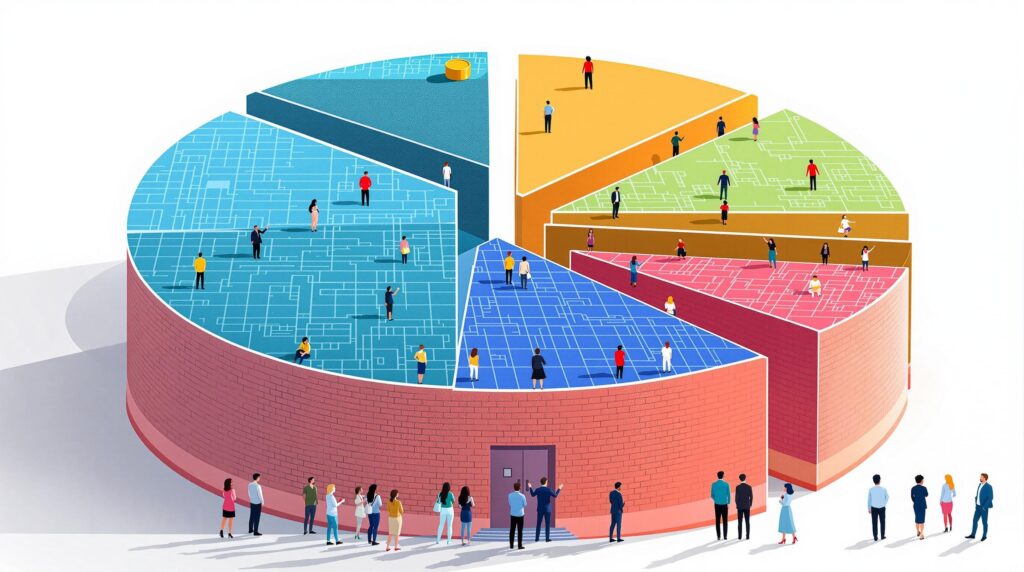[rev_slider alias=”slider-1″][/rev_slider]
Understanding Layer 1 Blockchains
Layer 1 blockchains form the foundational architecture of the entire blockchain ecosystem. At their core, Layer 1 blockchains are the primary protocols, like Bitcoin and Ethereum, that manage and record transactions directly on their own network. These blockchains are independent and do not rely on another network for functionality. But why are they so essential?
Layer 1 blockchains are often referred to as the “mother chains” because they host the main database for all transactions and smart contracts, operating as the bedrock upon which Layer 2 solutions build.
Why does this matter? In simple terms, Layer 1 blockchains ensure the reliability and security of transactions across the blockchain universe. The likes of Bitcoin and Ethereum are pivotal because they embody decentralization at its most fundamental level, allowing peer-to-peer exchanges without the need for intermediaries.
Core Functions of Layer 1
Let’s delve deeper into what makes Layer 1 tick. These blockchains control and validate all transactions occurring on their network while ensuring adherence to the underlying protocol rules. But how does this translate into daily operations?
- Decentralization: Layer 1 blockchains distribute control across numerous nodes globally, thereby eliminating single points of failure and enhancing security. Think of it as having thousands of security guards who ensure that transactions are conducted fairly and openly.
- Security: This attribute ensures that once transactions are recorded, they cannot be altered or reversed. Imagine it as writing with permanent ink – what’s done is done, securing every piece of history on the blockchain.
- Scalability: Although challenges exist, Layer 1 solutions continually seek ways to improve transaction capacity, paving the way for more robust systems that can handle increased demand without sacrificing speed or reliability.
- Transaction Processing: As the primary layer, Layer 1 executes and records every transaction on the blockchain itself, acting as the fundamental engine that keeps all operations moving smoothly.
Did you know? Bitcoin’s Layer 1 blockchain processes approximately 7 transactions per second, whereas Ethereum handles 15-30. These figures highlight the ongoing challenges in scalability and the need for Layer 2 solutions for enhanced throughput.
When considering Africa’s rapidly evolving digital landscape, the relevance of these technologies becomes even more pronounced. The integration of Layer 1 blockchains, like Ethereum, into financial systems can revolutionize economic empowerment and support the continent’s burgeoning tech ecosystem. As the foundation for the Jara platform, the potential to innovate and expand within these parameters is limitless.
It’s easy to get caught up in the technical jargon, but at its heart, a Layer 1 blockchain is all about trust – creating an indisputable ledger open to anyone and resistant to manipulation. For African economies, this can mean unleashing unprecedented opportunities for growth and inclusion.
The Emergence of Layer 2 Solutions
In the ever-evolving world of blockchain technology, Layer 2 solutions have emerged as a critical development aimed at enhancing the efficiency of Layer 1 blockchains. But why are Layer 2 solutions necessary? As blockchain networks like Bitcoin and Ethereum have gained popularity, they have encountered significant scalability issues. Layer 2 solutions address these problems by processing transactions off the main blockchain (Layer 1), thereby alleviating congestion and improving transaction speed and cost-effectiveness. Some notable examples include the Lightning Network and Optimistic Rollups, both of which have radically transformed how we perceive blockchain’s potential.
Benefits of Layer 2
The advantages of implementing Layer 2 technologies within the blockchain ecosystem are numerous and impactful:
- Increased Transaction Speed: By handling a significant number of transactions off-chain, Layer 2 solutions can dramatically speed up transaction processing times, making blockchains more viable for everyday use.
- Reduced Costs: With fewer transactions occurring on the Layer 1 blockchain, the associated costs for users can be significantly lowered, breaking barriers to entry for many potential users.
- Enhanced Scalability: Layer 2 solutions effectively increase the network’s ability to handle a higher volume of transactions, putting an end to bottleneck issues that have plagued Layer 1 blockchains.
- Improved User Experience: Faster and cheaper transactions lead to a smoother and more user-friendly experience, which is critical as blockchain technologies aim to attract a broader audience.
To understand the implications of Layer 2 solutions, think of them like express lanes on a busy highway—designed to handle high volumes of traffic without the delays of congestion, effectively enhancing the overall efficiency and appeal of blockchain networks.
Layer 2 solutions provide a vital framework to address the scalability disorders that Layer 1 blockchains experience, making blockchain technology more accessible and functional.
By offering innovative ways to increase transaction speeds and decrease costs, while also improving scalability and user experience, Layer 2 technologies are gaining traction not just in technical circles but also among everyday users. The seamless integration of these solutions is paramount as we bridge global capital to African assets, leveraging blockchain for financial inclusion and economic empowerment.
For those eager to explore the potential of Layer 2 solutions further, the opportunities are as vast as the challenges they solve. Just as $JARA is creating new avenues in Africa’s digital revolution, those leveraging Layer 2 technologies are laying the groundwork for the future of decentralized finance and beyond.
[rev_slider alias=”text-call-cta”][/rev_slider]
Layer 1 vs. Layer 2: Comparing Approaches
In the dynamic world of blockchain technology, understanding the differences between Layer 1 and Layer 2 blockchains is essential. These two layers serve distinct purposes and, when combined, can offer powerful solutions to several challenges faced by blockchain networks, especially those concerning scalability, transaction costs, and security.
Complementary Dynamics
Layer 1 and Layer 2 blockchains work in a coordinated fashion, much like the teamwork between a ground-level infrastructure and supplementary support systems in any advanced network. Layer 1, often regarded as the foundational base, provides the core elements such as security and validation. To optimize functionality, Layer 2 systems are built on top of it to handle transactions more swiftly and at lower costs.
Consider the network dynamics of Layer 1, which includes blockchains like Bitcoin and Ethereum. These are referred to as the “main chains” because they incorporate the primary protocol. However, as the number of users and transactions increases, the burden on Layer 1 systems escalates, leading to higher transaction costs and slower speeds.
What is a Layer 1 Blockchain? A Layer 1 blockchain refers to the base-level protocol such as Bitcoin or Ethereum, where fundamental processes like consensus mechanisms occur.
Layer 2 solutions are like adding expressways to a crowded road system, allowing more cars to travel quickly without all lining up on a single route. This complementary layer is crucial for boosting transaction speed and reducing congestion on Layer 1 networks.
How do Layer 1 and Layer 2 work together? Layer 1 provides core security and processes, while Layer 2 enhances transaction speed and reduces costs by handling additional processes on top of the Layer 1 protocol.
The integration of Layer 1 and Layer 2 is proving to be a staple in enhancing blockchain technology, particularly in markets like Africa where scalability and efficiency are critical. With these layers working together, solutions such as Jara’s proprietary Layer 2 blockchain embolden the digital financial ecosystem in Africa, effectively bridging global investment with local development projects.
This synergistic operation allows users to enjoy the benefits of a secure foundation while also taking advantage of rapid, cost-effective transactions. In essence, both layers are not only necessary; they complement each other to create a comprehensive operational framework.
As we continue to explore the unique dynamics between Layer 1 and Layer 2, it’s crucial to understand their specific roles and benefits to fully grasp how they are reshaping the blockchain landscape, especially within burgeoning digital economies like Africa.
Future of Blockchain Solutions: Do We Need Both?
In the realm of blockchain technology, the discussion around the necessity of both Layer 1 and Layer 2 solutions continues to gain traction. This exploration is crucial for understanding how these technologies can coexist and complement one another in the rapidly evolving crypto landscape. As blockchain platforms aim for wider adoption, it’s essential to consider their implications on global financial systems, especially within emerging markets like Africa.
Long-term Vision
As we look into the future, the long-term development of Layer 1 and Layer 2 blockchain solutions seems poised to alter the financial ecosystems worldwide dramatically. Layer 1 blockchains, such as Bitcoin and Ethereum, are considered the foundational infrastructure. They provide security and decentralized consensus but often face limitations in terms of scalability and transaction speeds. On the other hand, Layer 2 solutions offer scalability by processing transactions off the main chain, which helps in alleviating congestion and reducing fees.
Why consider both Layer 1 and Layer 2? These structures work together to optimize efficiency — Layer 1 provides security, while Layer 2 ensures scalability. Together, they create a more efficient and user-friendly blockchain environment.
In Africa, where financial inclusion and infrastructure development are major priorities, the implementation of both layers can significantly impact the economy. By investing in Layer 2 technologies, not only does it address the existing limitations of current systems, but it also opens up new avenues for transactional efficiency and accessibility in underbanked regions. The potential impact on global capital flow is immense, catalyzing a shift towards more inclusive financial systems.
Envisioned for the next decade, these technologies will likely evolve hand in hand with advancements in AI and data infrastructure. Integrating blockchain solutions with AI will furnish additional enhancements, like automated compliance checks and real-time fraud detection, thereby expanding their utility beyond simple financial transactions.
“Invest in $JARA: Fuel Africa’s $200B+ Digital Asset Economy and Participate in a Revolutionary Ecosystem” is not just a tagline; it’s a step toward a new digital-era frontier that Africa is poised to originate with the strategic deployment of Layer 2 technologies.
The Jara ecosystem exemplifies how these innovations can be implemented effectively. By leveraging its proprietary Layer 2 blockchain as presented in Jara’s digital infrastructure, Seamless, Socially Integrated Wallet becomes a reality. This approach not only accelerates transactions but also broadens reach, providing utility and ease of use for users. The institution’s long-term vision includes becoming a leading force in Africa’s financial revolution, reinforcing the essence of having both blockchain layers functioning harmoniously.
As we deepen our understanding of the crucial roles played by Layer 1 and Layer 2 solutions, it becomes apparent that they are not only desirable but essential for the future of blockchain technology in global and particularly African markets. Their integration provides a robust framework for economic empowerment and the creation of transparent, efficient, and accessible financial systems.
[rev_slider alias=”schedule-consultation-btn”][/rev_slider]

Why is scalability a challenge for Layer 1 blockchains?
Scalability is a challenge for Layer 1 blockchains because they are designed to ensure high levels of security and decentralization, which often comes at the expense of transaction throughput. As more users join the network, the demand for transactions increases, leading to congestion and higher fees. This limitation is inherent in the consensus mechanisms of Layer 1, such as proof-of-work used by Bitcoin.
Layer 1 blockchains, like Bitcoin, face scalability issues due to their reliance on proof-of-work, which prioritizes security and decentralization over transaction speed.
How do Layer 2 solutions improve blockchain performance?
Layer 2 solutions improve blockchain performance by enabling off-chain transactions, which reduces the load on the Layer 1 network. These solutions, such as the Lightning Network, handle transactions off the main blockchain while ensuring they eventually settle on it. This approach leads to faster transaction speeds and lower costs, without compromising security.
Layer 2 solutions like the Lightning Network allow faster transactions by handling them off-chain, significantly enhancing performance without sacrificing security.
What role do smart contracts play in Layer 1 and Layer 2 blockchains?
Smart contracts are self-executing contracts with the terms directly written into code. On Layer 1 blockchains like Ethereum, they enable decentralized applications (dApps) to run on the blockchain. In the context of Layer 2, smart contracts can be used to facilitate faster and cheaper transactions by executing contracts off-chain and only settling the final state on the Layer 1 chain.
Smart contracts execute code on the blockchain to automate transactions, playing essential roles in both Layer 1 dApps and Layer 2 efficiency enhancements.
Are Layer 1 and Layer 2 solutions necessary for future blockchain scalability?
Layer 1 and Layer 2 solutions are both necessary for future blockchain scalability because they address different aspects of the limitations faced by current blockchain technologies. Layer 1 provides the foundational security and decentralization, while Layer 2 offers enhanced performance and scalability. Together, they create a more efficient and robust blockchain ecosystem capable of supporting greater adoption and various use cases.
Both Layer 1 and Layer 2 solutions are crucial for scalable, efficient blockchain systems by combining foundational security with improved transaction speeds.

Related Practice Areas
Explore additional resources and practice areas that complement our exploration of blockchain technologies and their applications.
Hear From Our Satisfied Clients
At the forefront of our Layer 1 and Layer 2 blockchain solutions practice is a deep-seated commitment to client satisfaction. Each case is handled with utmost care, as echoed in the appreciative feedback from those we represent.

[rev_slider alias=”slider-3″][/rev_slider]
[rev_slider alias=”slider-6″][/rev_slider]
Ready to Explore the Future of Blockchain with Jara?
At Jara, we understand the ever-evolving landscape of blockchain technology and its potential to revolutionize global financial systems. Our expertise in Layer 1 and Layer 2 solutions positions us as leaders in the field, helping bridge global capital to African assets. Ready to dive deeper into the world of blockchain with us? Contact us through [email protected] or explore our cutting-edge solutions on the Jara website.
Awards and Recognition
- Listed among the “Top Blockchain Innovators in Africa” 2023 – by TechRevolution. Recognized for bridging global capital to local assets. Learn more
- Highlighted among the “Best Financial Technology Solutions” 2023 – by FinTech Awards. Celebrated for pioneering Layer 2 solutions. Learn more
- Featured in “Leading Crypto Solution Providers” 2023 – by CryptoTimes. Acknowledged for innovation in Layer 1 blockchain technology. Learn more
- Recognized among the “Top 10 Blockchain Enterprises” 2023 – from Global Blockchain Consortium, for excellence in technology integration. Learn more
- Selected as one of the “Innovative Fintech Leaders” 2023 – by FinTech Giants. Awarded for contributions to scalable blockchain solutions. Learn more
Chinyere “Chi” Nnadi Bio
Founder and CEO, Jara | Blockchain Specialist
Content reviewed by Chi Nnadi and his dedicated team. Chi is a visionary entrepreneur committed to revolutionizing Africa’s financial landscape through blockchain solutions. As Founder and CEO of Jara, he is at the forefront of converting illiquid African assets into internationally tradable digital tokens, using proprietary Layer-2 blockchain technology.
Our Content Review Process
Chi Nnadi along with Jara’s dedicated content team, pledge to offer top-notch material. Our content guidelines ensure thoroughness, reputable sources, unbiased scrutiny, among other quality metrics. Please let us know if there is anything you believe to be inaccurate.
















